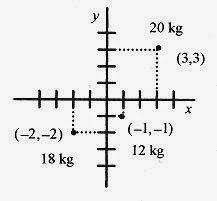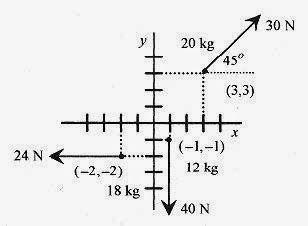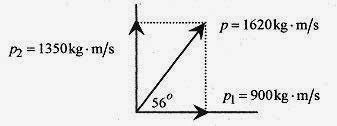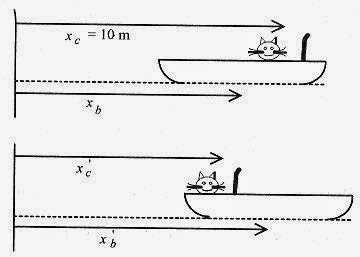Momentum Analysis
A discussion of the application of the law of conservation of momentum starts with a consideration of the center of mass of a collection of particles. For discrete mass points the center of mass is defined as
and likewise for y and z if the masses are distributed in two or three dimensions. A more powerful vector notation is
9 1 Calculate the center of mass for a distribution of mass points as shown in Fig. 9 1.
Solution:
The rcm form indicates that the calculation is to be done in vector notation, so (The units are often left our of calculations involving unit vectors and added at the end.)
These mass points act as if all of their mass (50kg) were at the point (0.72,0.24). If these three masses were placed on a plate of negligible mass, the balance point would be at (0.72,0.24).
The law of conservation of momentum can be viewed as a consequence of the statement: The total mass of a collection of particles times the acceleration of the center of mass equals the applied, or external, force, that is, the sum of the forces on all the individual component masses. This is of course a vector equation.
9 2 For the same collection of masses at the same points, as in problem 9 1, add forces as shown in Fig. 9 2 to each mass and find the resultant acceleration of the center of mass.
Solution: Remember: the acceleration of the center of mass is the total mass times the vector sum of all these forces. Applying equation 9 3
so
If the previous statement Fext = macm is viewed as 
then if Fext = 0, mvcm must be a constant. (The derivative of a constant is zero; or viewed graphically, if the curve of mv versus time is a constant then the slope is zero.)
Stated another way: For a system with no external forces the sum of the momentum vectors m1v1+m2v2+ c,which add to mvcm, must all add to zero.
<><><><><><><><><><><><>
9 3 A 5.0g pellet is compressed against a spring in a gun of mass 300g. The spring is released and the gun allowed to recoil with no friction as the pellet leaves the gun. If the speed of the recoiling gun is 8.0m/s, what is the speed of the pellet?
Solution: This problem is solved by application of the law of conservation of momentum. This law can be applied because there is a no external force. Since there is no external force, all the mv’s must add to zero.
The conservation of momentum statement on the left is based on the simple observation gbullet go one way, gun go the other,h while the formal statement that the mv’s add to zero is on the right. With a well labeled diagram of the situation, the statement on the left is probably easier to visualize, that is, the momenta are equal and opposite. Putting in the numbers
As a check, not that the momentum of the gun pg = mgvg = 2.4kg.m/s and the momentum of the pellet pp = mpvp = 2.4kg.m/s are numerically equal and since they are in opposite directions add to zero.
The energy of each is mv2/2 or p2/2m. So for the gun
Performing the same calculation for the pellet
The total energy stored in the spring is the sum of these energies or 298J.
<><><><><><><><><><><><>
9 4 Make the pellet gun of problem 9 3 fully automatic and capable of firing 10 pellets per second. Calculate the force these pellets make on a target where the pellets do not bounce.
solution: This problem is solved by calculating the average momentum transferred to the target per unit of time. The momentum of each pellet is 2.4kg.m/s. The force on the target is calculated from the simple expression
The total momentum transferred each second is 10 individual momenta of each pellet.
<><><><><><><><><><><><>
9 5 A 75kg hockey player traveling at 12m/s collides with a 90kg player traveling, at right angles to the first, at 15m/s . The players stick together. Find their resultant velocity and direction. Assume the ice surface to be frictionless.
Solution: This problem can be analyzed by conservation of momentum. Calculate the momenta and draw a vector diagram.
The angle of the two hockey players is from ![]()
or ƒÆ=56‹, and the resulting momentum is
The players move off with velocity ![]()
at an angle of 56‹ to the original direction of the 75kg player.
Second Solution: A more formal approach is to write a conservation of momentum statement equating the total (vector) momentum before the collision to the total (vector) momentum after the collision. Take the plus i direction as the initial direction of the first player and the plus j direction as the original direction of the second player. Using the numbers already calculated
As an exercise verify the final velocity of 9.83m/s at the 56‹ angle.
<><><><><><><><><><><><>
James Bond is skiing along being pursued by Goldfinger, also on skis. Assume no friction. Mr. Bond, at 100kg, fires backward a 40g bullet at 800m/s. Goldfinger, at 120kg, fires forward at Bond with a similar weapon. What is the relative velocity change after the exchange of 6 shots each? No bullets hit Bond or Goldfinger.
Solution: The problem is analyzed with conservation of momentum. The mbvb of the bullet fired by Bond increases his momentum by mBƒδvB. Remember that each bullet Bond fires increase his velocity. Set mbvb = mBƒδvB and solve for δvB
The 40×10 –3 kg bullet is small compared to the 100kg of Bond, and it would not affect the calculation. The δvB notation is used to indicate that each bullet fired by Bond causes a change in his velocity.
Goldfinger, on the other hand, has his momentum decreased. In his case, mbvb = mGδvG.
Putting in the numbers
Bond goes faster and Goldfinger goes slower with the total change in velocity 0.58m/s for each pair of shots fired. For six shots this amounts to a difference of 3.48m/s. If Bond and Goldfinger had been traveling at the same speeds, then after this exchange Bond would have a relative speed advantage of 3.48m/s.
<><><><><><><><><><><><>
A 3000kg closed boxcar traveling at 3.0m/s is overtaken by a 1000kg open boxcar traveling at 5.0m/s. The cars couple together. Find the resultant speed of the combination.
Solution: The momentum before coupling is the same as the momentum after coupling (no external forces).
<><><><><><><><><><><><>
9 8 Continuing problem 9 7, rain falls into the open boxcar so that the mass increases at 1.0kg/s. What is the velocity of the boxcars at 500s?
Solution: The total momentum of the boxcars is 4000kg(3.5m/s=14000kg.m/s. Assume there is no horizontal component of the rain to change the momentum in the direction of motion of the boxcars. The mass increases by (1.10kg/s)3.5m/s=500kg. The momentum is a constant, so the new velocity is
<><><><><><><><><><><><>
9 9 For the situation described in problems 9 7 and 9 8, what is the rate of change in velocity for the boxcars?
Solution: This is a very interesting calculus problem that involves taking the total derivative. Since there are no external forces, the total change in mv must equal zero so
Now write m as a function of timem = mo + rt=4000kg + (1.0kg/s)t. The derivative of m is dm = rdt.
Using the previous two equations and rearranging
Introduce a change of variable
Integrating, 1n v= 1nu + 1n K. Use 1n K because it is a convenient form for the constant.
Now rearrange: 1nv + 1nu=1nK and 1nuv=1n K or uv=K
change the variable back to t so (mo + rt) v =K.
Evaluate the constant from the condition that at
The relation between
The velocity at
Conservation of momentum and a little calculus produce the v versus t relation.
<><><><><><><><><><><><>
A 3.0kg cat is in a 24kg boat. The cat is 10m from the shore. The cat walks 3.0m toward the shore. How far is the cat from the shore? Assume no friction between boat and water.
Solution: There are no external forces so the center of mass of the cat boat system is constant. Knowing that the center of mass doesn’t move is all that is necessary to do this problem.
Referring to Fig. 9 5, write the center of mass of the cat boat system before the cat walks. (M is the mass of the boat and m the cat.) Then write the center of mass of the cat boat system after the cat walks.
Because there are no external forces the centers of mass are the same so
Watch the algebra and solve for xc. Use a word statement before writing the algebra statement. gThe final distance of the cat from the shore is equal to the original distance of the cat from the shore plus the displacement of the cat relative to the boat and the displacement of the boat relative to the shore.h Read the sentence, look at the diagram, and write
Now substitute from M(xb xb=m(xc xc) or xb xb =(m/M)(xc xc),
<><><><><><><><><><><><>
9 11 Rabbit food in the form of pellets is poured onto a scale pan at the rate of 400 pellets per second. Each pellet has a mass of 20g and falls a distance of 2.0m. Assuming the pellets do not bounce, calculate the scale reading at 7.0s.
Solution: There are two components of the force. Momentum is transferred to the scale pan giving a constant force. The pellets are accumulating in the scale pan giving a time dependent part of the force.
First calculate the velocity of the pellets as they hit the scale pan.
The momentum for each pellet is mv=0.020kg(6.26m/s)=0.125kg.m/s
The total force due to this momentum transfer is 400 mv’s per second
The force due to accumulation is the weight of each pellet times the number per second (ƒÊ), times the number of seconds.
The scale reading at 7.0s is the sum of these two components or 599N.



















